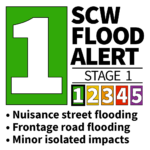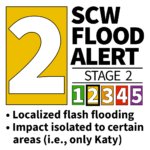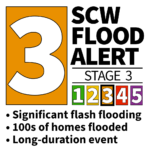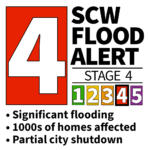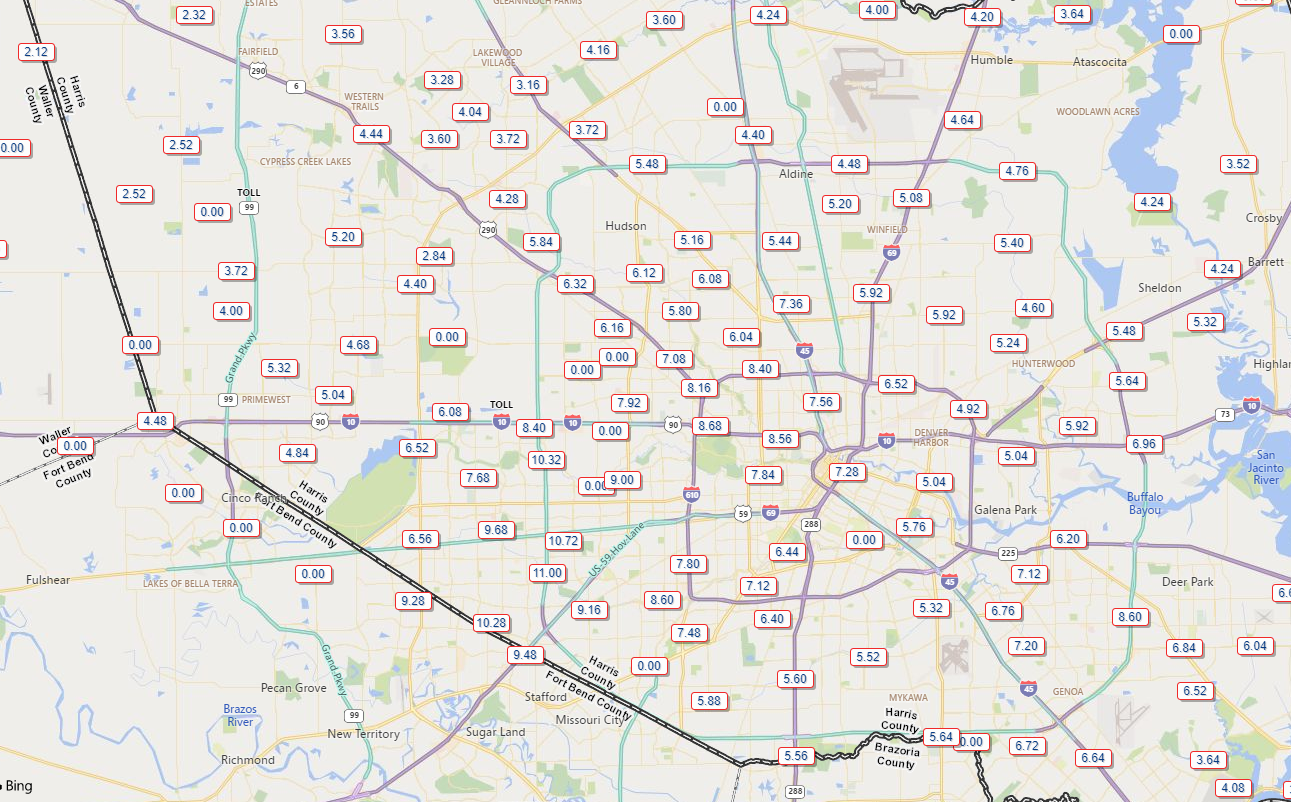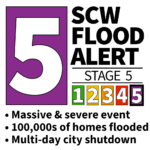It has been six years since we first introduced our flood scale on Space City Weather, back in 2019. We created the scale to help guide expectations for people in the greater Houston region when it comes to the potential for flooding. Recently, we partnered with researchers at the University of Houston to better understand how readers were using and interpreting our scale. As a result, we modernized the scale to make it more accessible, and provide more actionable information. As of July 2025, this is our revised scale:
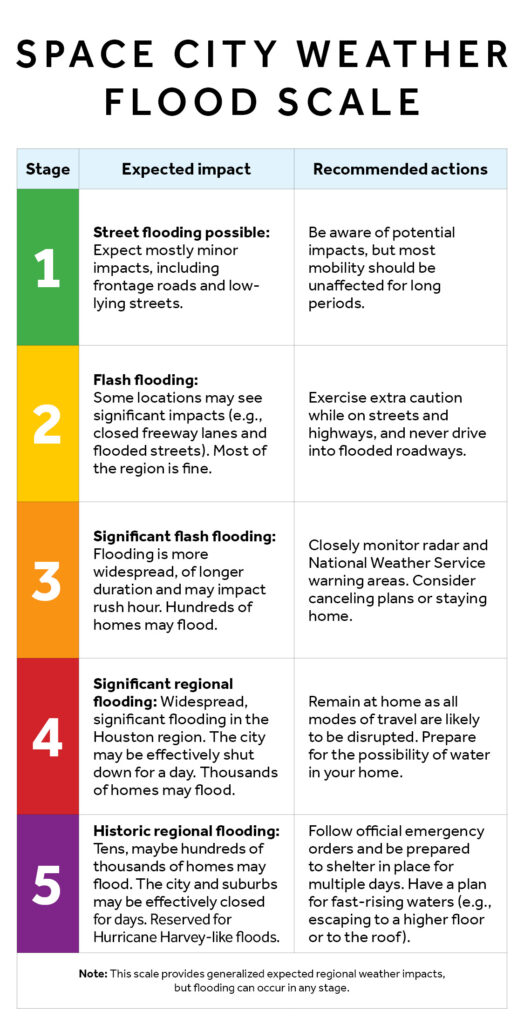
When we first introduced the flood scale, we didn’t really go too much depth on the various stages. We now realize that leaving any ambiguity in the interpretation of this was probably a mistake, so the goal here is to explain our scale in more depth and detail so readers have complete clarity on what it is meant to convey.
Origin & what it does
In the wake of Hurricane Harvey and all the flooding events in recent years, it occurred to us that we needed a way to put future rain forecasts in context with past events. We decided on a five-stage, or category scale. The scale is not meant to be perfect for everyone. Nor is it meant to replace forecast advice or direction from the National Weather Service or emergency managers. All it is meant to do is to set a realistic expectation ahead of a rainfall event that we feel could produce newsworthy flooding. We just want to attempt to help people navigate their anxieties regarding flooding that we know are widespread after recent years.
The scale is meant to characterize, in the general grand scheme of things, how the flood will be remembered for in Houston. Yes, your car may flood in a nuisance street flooding event, “only” a stage 1 on our scale. For you, personally, that may be a stage 5 life event. While that would certainly be unfortunate, for the greater Houston area, nuisance street flooding is rather common, and Stage 1 events happen at least a few times per year. What we want to do is make sure people understand that an upcoming rain event is more like that than a Memorial Day 2015 event, a Tax Day 2016 event, or an Imelda, and vice versa.
What it does not do
This scale is not going to tell you if you will experience flooding. Every flood event is unique. Just because you may have received 40 inches over 5 days and not flooded during Harvey, that does not mean you also won’t flood during a storm that only produces 6 inches of rain that falls in a single hour. Flooding in any given rainstorm depends on numerous factors, including quantity of rain, duration, intensity, neighborhood drainage, and conditions in place prior to the rain. Since no two storms are identical, you cannot always rely on past storms to tell you how future ones may impact you in your backyard.
The historic examples are not meant to apply perfectly to any one individual neighborhood. We may classify an event as stage 2 because it caused localized flooding in The Woodlands or Kingwood or Sugar Land. For some folks in those neighborhoods that flooded, that historic example may feel like a stage 3 or 4 event because of the problems it caused you and your neighbors. In other neighborhoods, you may not have noticed a drop of rain. What we want to do is put the event into context in the Greater Houston area. This scale is a perfect example of “your mileage may vary.” We recognize that, but we also know there is no perfect scale. This is the closest thing we could think of to a one-size fits all solution.
The scale is just attempting to characterize the “personality” of the flooding event we expect.
Let’s take you through each stage and discuss what each one means and what the past events looked like.
Stage 1
Our first stage applies to what we see in Houston a few times each year. These are the nuisance street flooding events that may occur over parts of the city. This is the type of event where you say, “Oh, yeah, there will probably be high water on the frontage roads of 59.” Or, “I-45 at North Main probably is flooded.” The spots that typically see water cover the road when it rains heavily will likely see flooding or ponding in a Stage 1 event. Stage 1 events would be more of a widespread event over the city of Houston than anything.
Historic Stage 1 examples
January 18, 2017 flooding:
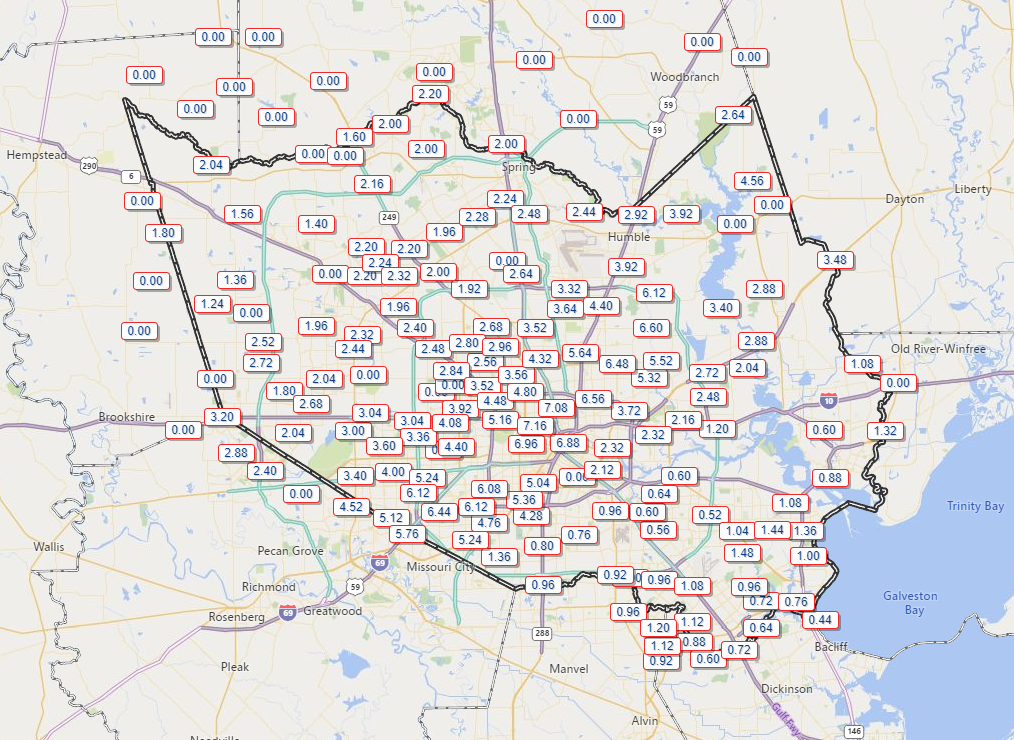
During this event, many Houston streets flooded right during the morning rush hour, as did some bayous. HISD had a two hour delayed start, and Highway 288 flooded.
May 20, 2018 Flooding in North Houston:
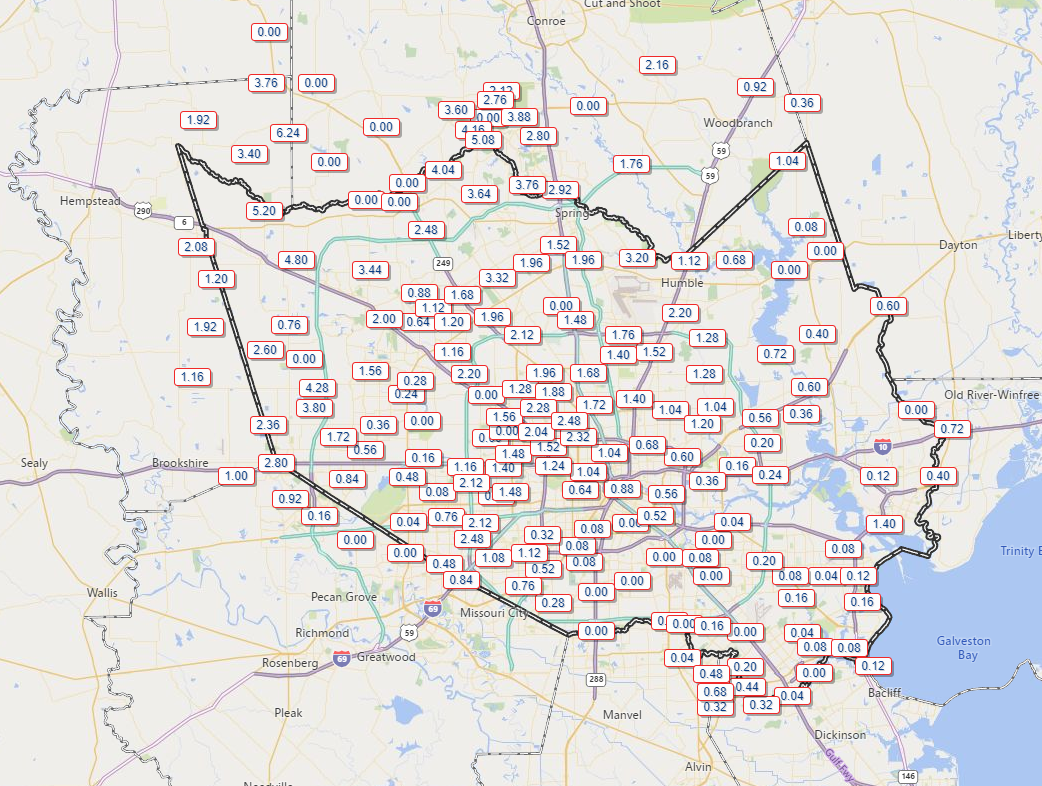
This event was mostly across northern Harris County into The Woodlands. Anywhere from 2 to 7 inches fell. Parts of southeast Harris County saw little to no rain. This primarily caused street flooding in that area.
Another Stage 1 example would be the flooding on July 4th, 2018 which postponed Houston’s non-fireworks festivities.
Stage 2
The second stage is meant to take things up a notch. Events falling into this category may cause significant, widespread street flooding across large swaths of the area, flooding numerous cars. Other examples of what we would consider stage 2 events are ones that flood dozens of homes in small, targeted areas or specific neighborhoods. These events are either moderate impact over a large area or high impact over a relatively small area.
Historic Stage 2 examples
Halloween 2015:
In the week leading up to Halloween in 2015, significant rain fell on most of the area, partially as a result of the remnants of Pacific Hurricane Patricia. While minimal flooding occurred with Patricia, it set the table for flooding by the weekend of Halloween. From October 31-November 1, as much as 12 to 13 inches of rain fell across eastern Harris County, leading to bayou and river flooding.
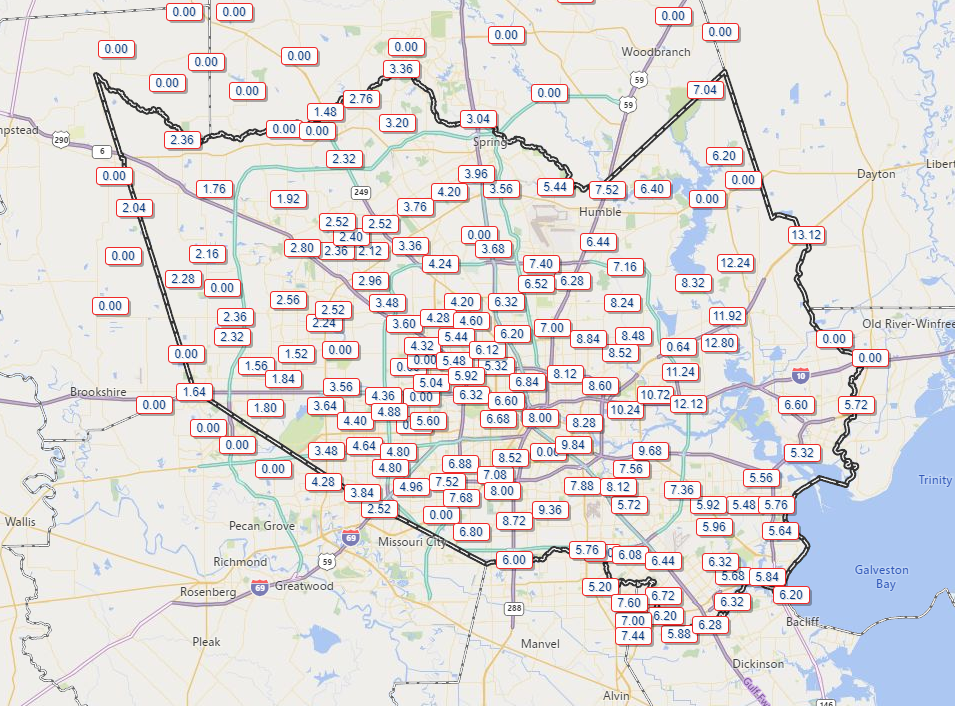
In much of central Houston and points west, flooding was mostly minor to moderate (or non-existent). As you moved east of downtown Houston, flooding issues worsened. We likely would have forecast a Stage 1 event leading into the storm. This may have qualified as a Stage 3 flood for parts of eastern Harris County, but we feel this verified as Stage 2 for the broader region as a whole.
Kingwood & Sugar Land flooding of May 7, 2019:
On May 7, 2019 isolated to scattered storms popped up across the Houston area. In most cases, locations saw anywhere from 1 to 4 inches of rain. A few spots saw more, but in Sugar Land and Kingwood, rains fell fast, furious, and led to widespread flooding in those communities.
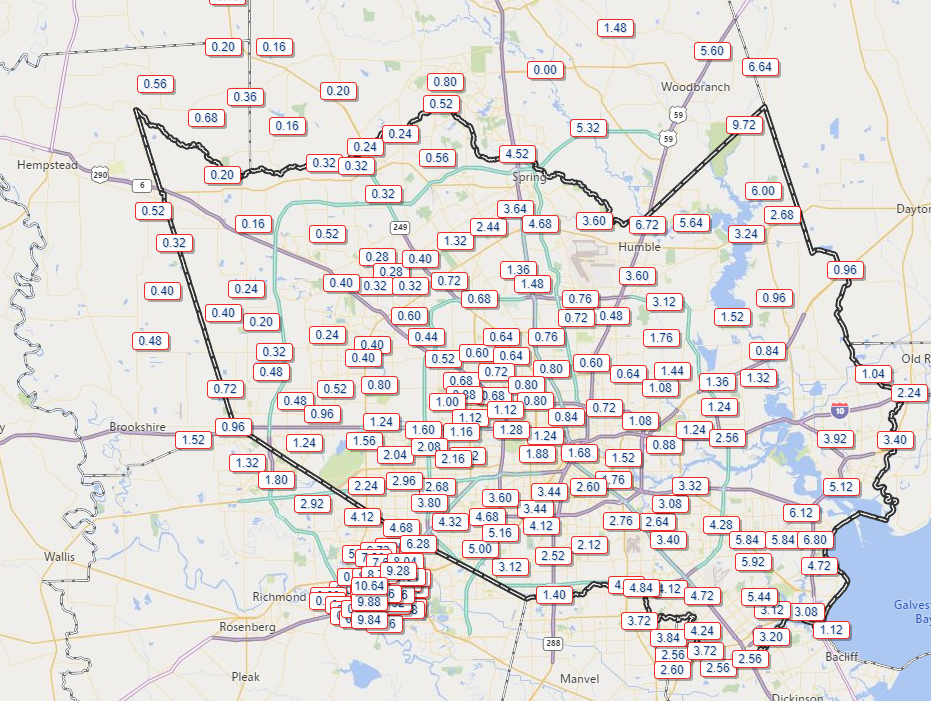
In Kingwood, the rains came in the afternoon, falling at the rate of as much as 3 inches in an hour. This overwhelmed drainage in the area, leading to around 150 homes being flooded. Later that day, heavy rain parked over Sugar Land, causing widespread street and car flooding. As much as 10 inches or even a bit more fell on May 7th there. This qualified as a Stage 2 flood because of significant but highly localized impacts.
Stage 3
Our third stage is probably the most difficult stage to define. These are storms that may be quite memorable for parts of the Houston area but not for the entire area. These are basically larger, more damaging versions of Stage 2 events. You could expect perhaps hundreds of homes flooding in multiple neighborhoods during Stage 3 events. We might also classify a longer-duration flood on the Brazos or San Jacinto River as a Stage 3, provided it impacts homes and neighborhoods significantly.
Historic Stage 3 examples
Memorial Weekend 2016 in Northern Harris County (May 26-27):
A very wet spring 2016 continued to roll through the month of May, capped off by a significant flooding event north of Houston on Memorial Day Weekend. The Thursday prior saw significant rainfall in the Brenham area, but on Friday we saw widespread heavy rain across the rest of the Houston area.
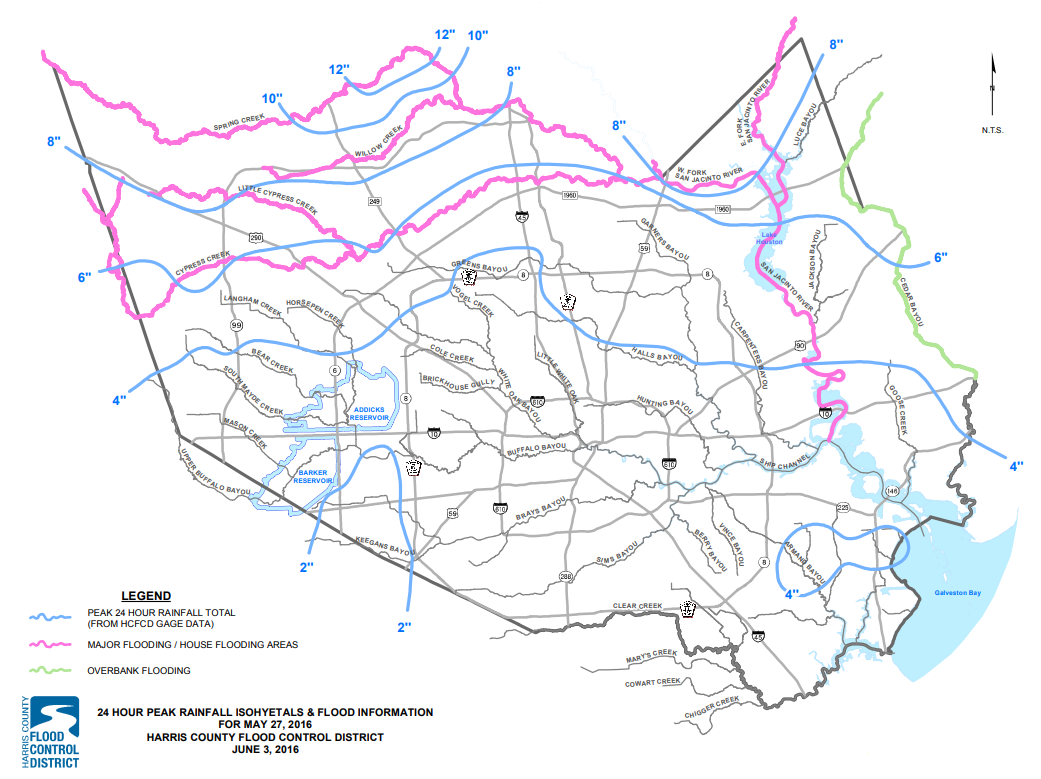
Rain totals exceeded as much as 13″ in far northern Harris County, all of which led to flooding along Spring Creek, Willow Creek, Little Cypress Creek, and Cypress Creek. In addition, both the Brazos and San Jacinto Rivers experienced significant flooding due to this event. Prior to Harvey, this event ended up being the flood of record on the Brazos River at Richmond, which crested at 54.74 feet.
Given the historic, long-duration flooding on the Brazos and the fact that about 100 homes were flooded across northern Harris County, this event ranks as a Stage 3 flooding event.
April 28, 2009 Flooding:
After an extremely stormy mid-April, a final round of rain moved through Harris County on April 28, 2009. Some parts of the county received in excess of 10 inches, some of which fell at 3 to 5 inch per hour rainfall rates.
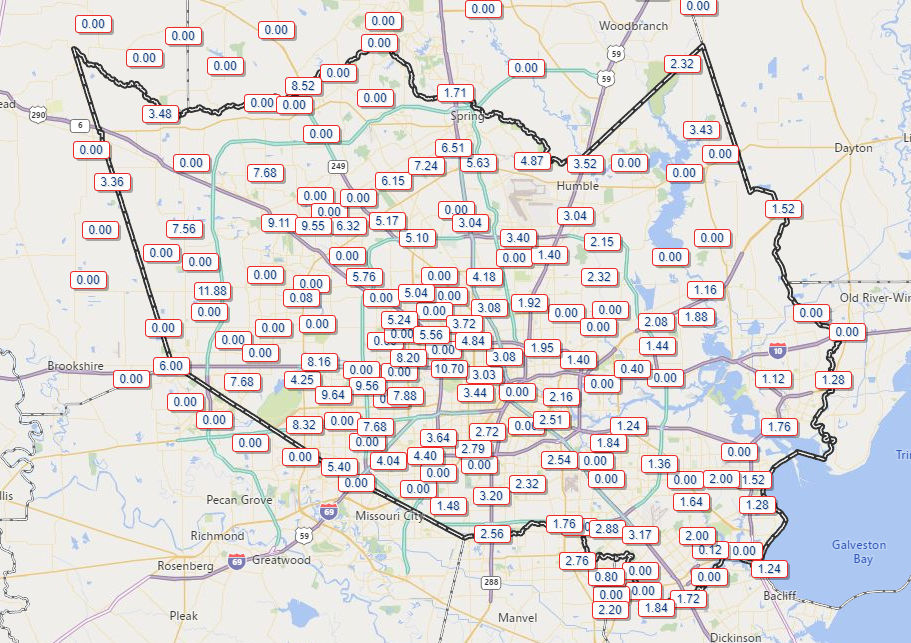
Approximately 2,150 homes were flooded across Harris County, mostly in Jersey Village and Bear Creek, in addition to widespread freeway flooding. Given the widespread impacts and significant home flooding in parts of the county, we rated this storm as a Stage 3 event.
Tropical Storm Imelda (September 17-19, 2019):
While this was extremely difficult to rank, we have settled on Imelda being a Stage 3 event for the Houston area. Damage is still being calculated, but early indications are that approximately 1,000 to 1,500 homes flooded, mostly in the eastern third of Harris County. For the Beaumont, Winnie, Liberty County areas, this event was clearly a Stage 4 or 5 storm. (Note this distinction on our revised flood scale above). While we have numerous readers from those areas, we want to keep the Space City Weather scale focused on the Houston area. For eastern Harris County, this was probably a Stage 4 storm. But for the city of Houston, however, this qualifies as a Stage 3 event. Some folks in western Harris County barely saw any rain at all, so this event may not have even registered out there. Thus, we have decided to compromise with labeling Imelda a Stage 3 storm for the Houston area.
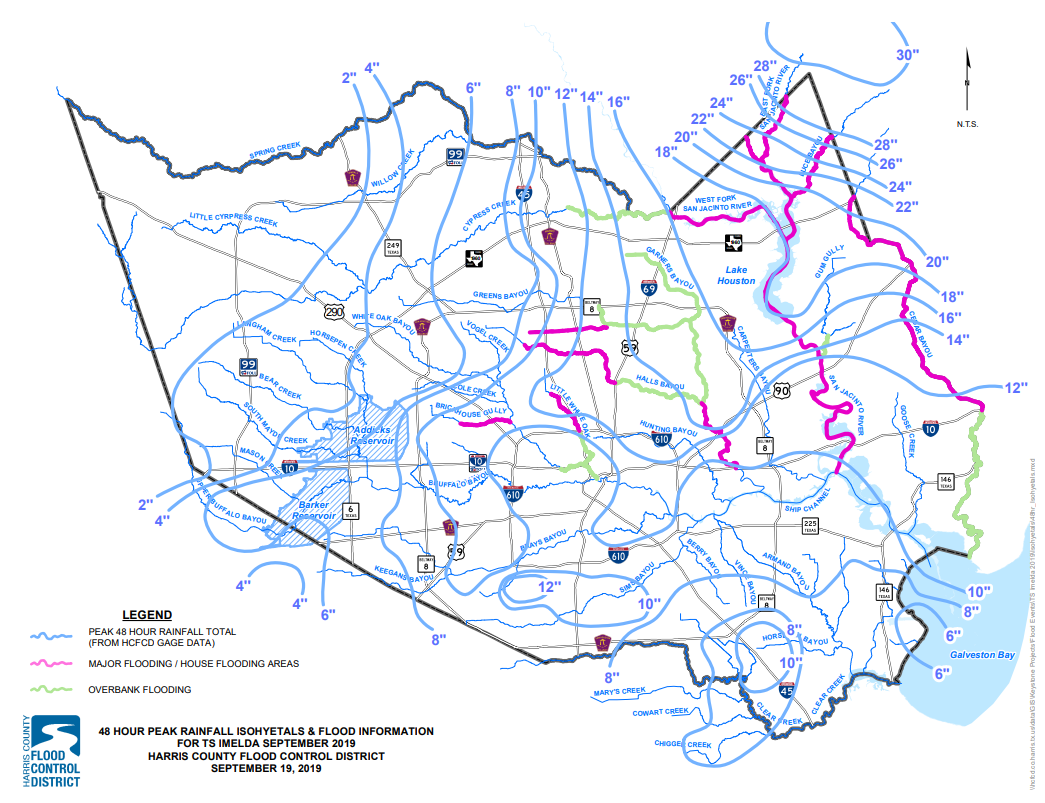
Imelda’s rainfall gradient was incredible across Harris County, with some places seeing less than 2 inches in the northwestern part of the county, while the northeast corner of the county hit about 30 inches over 48 hours. There were thousands of water rescues during this storm, particularly on Thursday the 19th, as rainfall rates locally in excess of 6 inches in one hour (6.4″ in one hour along Greens Bayou at Highway 59) moved south across the Houston area. These rainfall rates rivaled peak hourly rainfall rates of Harvey and Allison. Obviously, those two storms lingered longer in Houston, leading to catastrophic flooding.
Imelda will rank as a “100-year” storm, when using exceedance probability data from recently revised NOAA maps for the time periods of 3, 24, and 48 hour rainfall totals.
Stage 4
Getting into Stage 4 level storms is when you start getting into the extremely infamous events. These are storms that flood hundreds to thousands of homes, causing significant damage, leading to long-term impacts. Stage 4 events can usually be identified by name or date and most people will know of them.
Historic Stage 4 examples
Memorial Day 2015, May 25-26:
The Memorial Day 2015 flood featured the first instance of the National Weather Service forecast office issuing a “flash flood emergency,” the highest level of flood warning in the Houston area. It also began a series of floods in the Houston area, culminating with Hurricane Harvey in 2017.
11 inches of rain fell during a short period during the evening of Memorial Day (May 25), ending the next morning. Flooding was particularly catastrophic in the Meyerland neighborhood of Houston. When all was said and done, somewhere on the order of 2,500 to 3,000 homes had been flooded. This qualifies as a Stage 4 event because it produced an extreme amount of rainfall in a short period of time over Harris County.
Tax Day 2016, April 17-18:
The Tax Day storm was a ferocious flooding event for the Greater Houston area which flooded over 7,000 homes and caused over $2.5 billion in damage, mostly in Houston.

Over 20 inches of rain fell in far western Harris County during this storm, most of it in a 10 to 12 hour period. This established record flows at the time into Addicks and Barker Reservoirs west of Houston.
October 1994 flooding
Prior to Harvey and Tax Day and Allison, there was October 1994. This event was a long-duration one, featuring moisture from Pacific Hurricane Rosa, as well as moisture off the Gulf feeding a strong Plains/Rockies storm. The end result? Over 15,000 flooded homes and nearly $2 billion in damage.
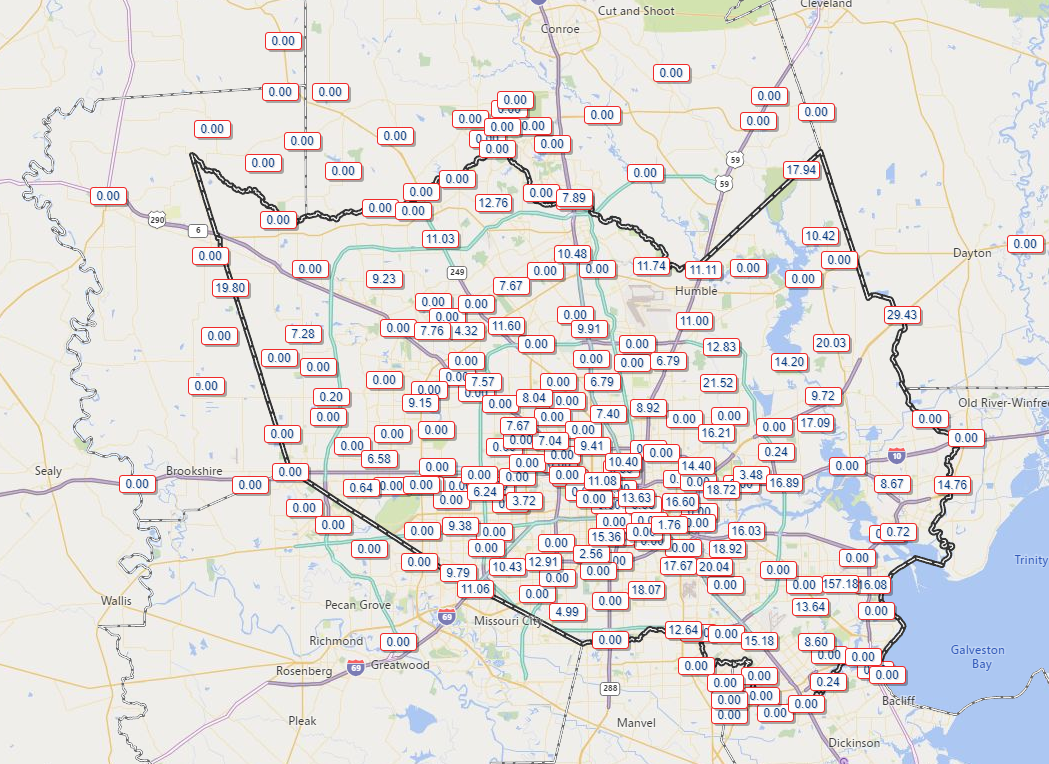
Over 20 inches of rain fell between October 15 and 19 across parts of eastern Harris County, as well as north of the Houston area. This led to catastrophic flooding along the San Jacinto River, Trinity River, as well as Cedar Bayou.
The most horrifying aspect of the 1994 flood was a ruptured gasoline pipeline in the San Jacinto River that ignited, leading to a massive fire and catastrophic damage along the riverfront.
Stage 5
Our highest level on the flood scale is reserved for only 2 entrants in modern history: Allison and Harvey. Prior to Harvey, 2001’s Tropical Storm Allison had been the benchmark storm in the Houston area, so much so that the Harris County Flood Control District’s post-storm report was entitled “Off the Charts.“
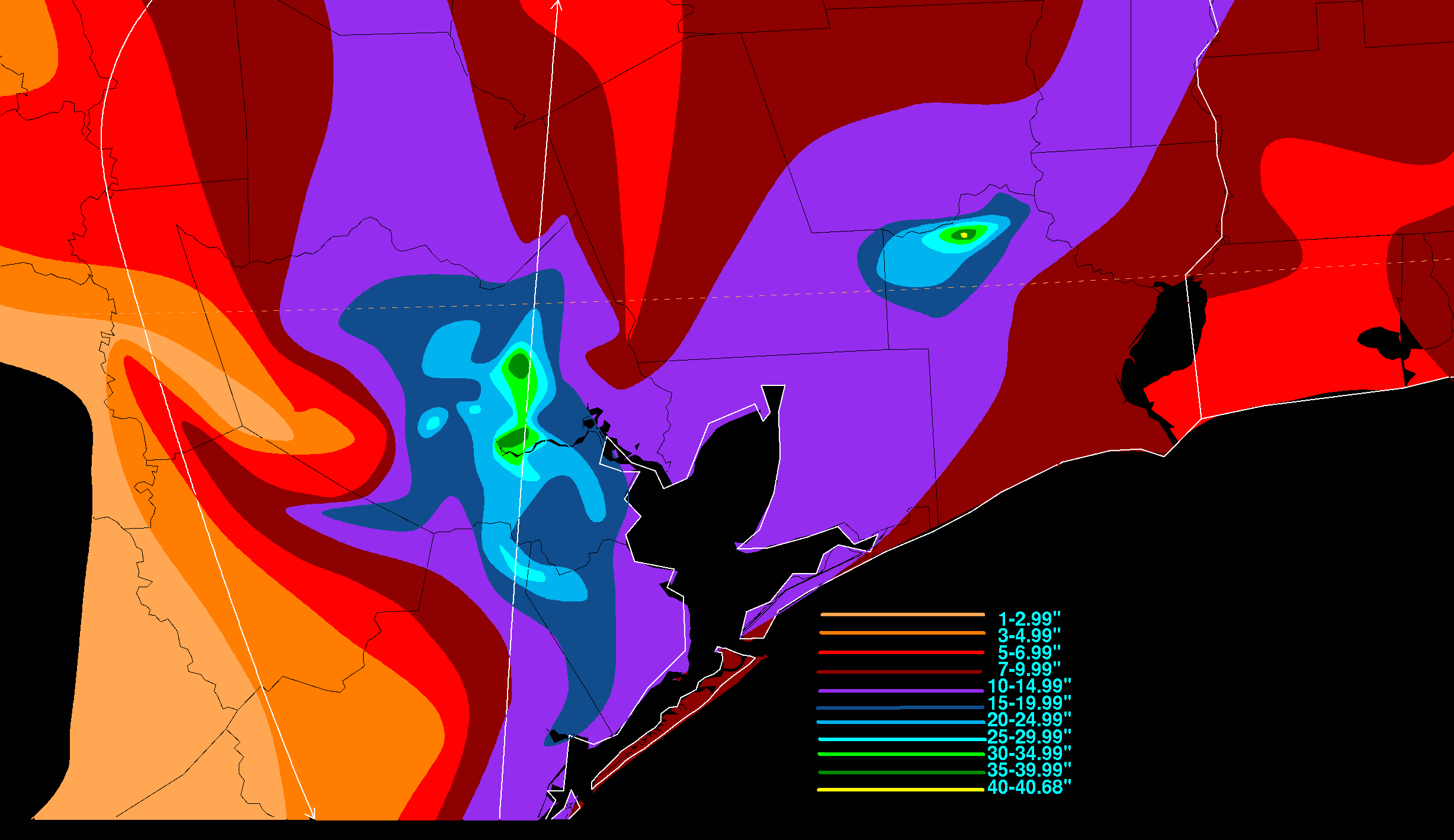
Allison dumped as much as 28 inches of rain in 12 hours and just shy of 40 inches of rain over 4 days. The resulting flooding was catastrophic, with over 70,000 homes damaged or destroyed. Damage exceeded $12 billion in total.
As for Harvey, what can be said that has not been said already? Harvey is the benchmark for storm events in Southeast Texas, and we hope that there never comes a day that we see anything remotely rivaling this in Houston. Harvey’s damage totaled at least $130 billion.
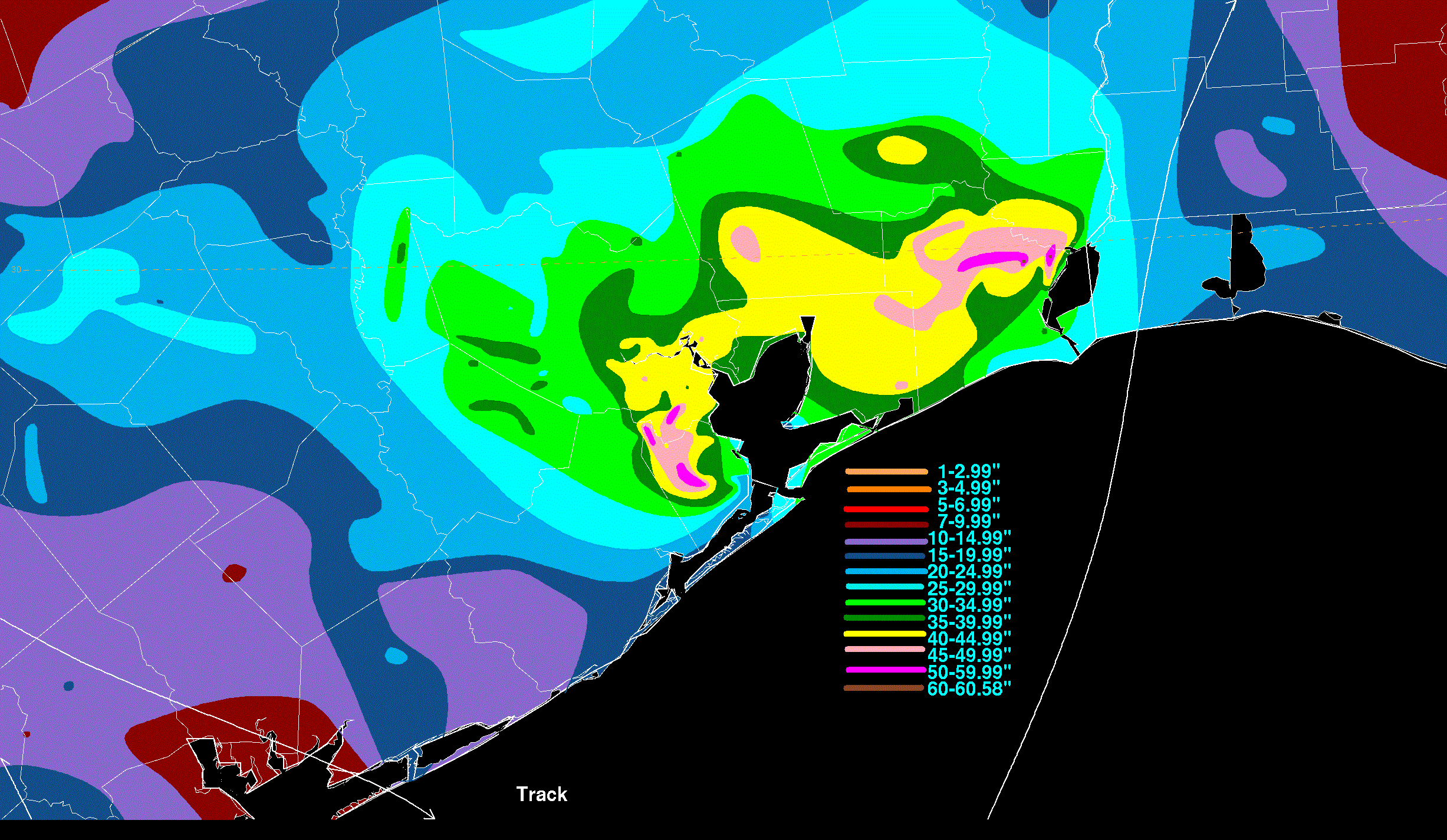
Over 150,000 homes flooded in Harris County alone. It is estimated that 300,000 vehicles also flooded during Harvey in Harris County.
Stage 5 events would be the rarest of the rare. We hope to never utilize this in our pre-storm messaging.
Note: All pages linked to in this post are live and working as of September 29, 2019. Please let us know if you encounter a broken link.
